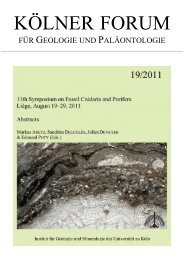Download (6Mb) - USP Electronic Research Repository - The ...
Download (6Mb) - USP Electronic Research Repository - The ...
Download (6Mb) - USP Electronic Research Repository - The ...
Create successful ePaper yourself
Turn your PDF publications into a flip-book with our unique Google optimized e-Paper software.
Benthic Marine Algae of Rotuma Island 363<br />
checklist of marine benthic algae from Dravuni Island, in the Astrolabe Reef region, listing a<br />
total of 71 species, 5 of which were new records for Fiji. South (1992) also published an<br />
illustrated catalogue of the Halimeda species reported from Fiji, and in 1993 reported on the<br />
edible seaweeds of these islands. <strong>The</strong> most comprehensive overview of Fijian algae to date is<br />
the 1992 checklist by South and Kasahara, listing a total of 314 species including 11<br />
Cyanophyceae, 99 Chlorophyceae, 36 Phaeophyceae and 168 Rhodophyceae. Since then,<br />
further additions to the flora were made by a number of researchers (Raj 1993; South 1993;<br />
South and N'Yeurt 1993; South et al. 1993; N'Yeurt et al. 1995, 1996a, 1996b), bringing the<br />
total Fijian macroalgal flora (including Rotuma) to 422 taxa. In addition, recent visits by<br />
D. S., and M. M. Littler, from the Smithsonian Institution in Washington, DC., to the Great<br />
Astrolabe Reef, Kadavu, have yielded many new records of benthic algae that await<br />
publication. However, most of the Fijian algal flora is still poorly known, as much of the Lau<br />
Group, Kadavu, Lomaiviti Group, Yasawas, Taveuni and Vanua Levu have yet to be<br />
investigated in detail.<br />
Materials and Methods<br />
Field Survey Methods<br />
An initial survey of the island was carried out, from January to May 1992. A further survey was<br />
conducted from December 1992 to February 1993, with additional specimens collected between<br />
September 1993 and January 1994, and between November 1994 and January 1995.<br />
A preliminary visual survey of the coastline was carried out, and 19 representative sites around the<br />
island were chosen for inspection (Fig. 1). Surveys were carried out either by wading or snorkelling.<br />
Considering the sparse distribution of the algae, and the turbulent and exposed conditions on the often<br />
very narrow fringing reefs, it was deemed impractical to lay transects. Instead, the area was visually<br />
inspected for algal growth, with salient distribution and reef profile features being recorded on an<br />
underwater writing board. Owing to the exposed nature of the reefs and the lack of diving facilities and<br />
trained partners, it was considered dangerous to sample subtidal habitats. Consequently, all collections<br />
were from the intertidal region, imposing obvious limitations on the overall results obtained.<br />
Photographs of algae in situ and of the general habitats were taken using an Olympus 35 mm camera<br />
and a Pentax SLR variable-focus camera. Algal specimens were hand-collected or scraped off the<br />
substratum using a knife, put into polyethylene plastic bags or vials, promptly preserved in 5%<br />
formaldehyde in seawater, and stored in light-proof plastic containers for eventual shipment back to Fiji.<br />
Laboratoiy Methods<br />
Hand-sections or freezing-microtome sections were made for general observation of internal<br />
anatomy. Slides were stained with either crystal violet or 1% acidified aniline blue, and made<br />
permanent if necessary by embedding in glycerine jelly (Drury et al. 1967) following impregnation of<br />
the material in 50% glycerol water solution for 2-3 h. Slides were examined using a Zeiss compound<br />
microscope. A camera-lucida attachment (Abb6 Drawing Tube, Carl Zeiss) was used to make pencil<br />
drawings of the specimens. Observations on larger specimens and general sorting of the collections<br />
were performed using a Labova dissecting microscope. Slides are housed in the South Pacific Regional<br />
Herbarium in a numbered series prefixed by 'S' (slide).<br />
Voucher specimens of larger algae were first dried using an algal press, then mounted onto<br />
herbarium paper. Specimens were deposited into the South Pacific Regional Herbarium housed at the<br />
University of the South Pacific in Suva. Collection numbers are preceded by '<strong>USP</strong>'. Ektachromes and<br />
black-and-white photographs of identified algae were obtained in the laboratory, either using formalin-<br />
preserved or pressed specimens. Macrophotography was undertaken with a Nikon F2A using a 55 mm<br />
1 : 3.5 lens, and a ring flash (Sunpak GX8R ring flash attachment, Sunpak Corporation, Tokyo, Japan) in<br />
conjunction with Kodak EClOO (Ektachromes) or Kodak PX125 (Black-and-white) film.<br />
Photomicrographs were taken with a Zeiss Photoscope I11 (*I S = slide collections. Accession numbers<br />
refer to specimens housed at the Phycological Herbarium, South Pacific Regional Herbarium, <strong>The</strong><br />
University of the South Pacific (SUVA) and are preceded by '<strong>USP</strong>' to distinguish them from the<br />
angiosperm collection).<br />
Taxonomy and Nomenclature<br />
Nomenclature used in identification of the algae follows that of Silva et al. (1987) unless stated<br />
otherwise. <strong>The</strong> lists of Tsuda and Wray (1977) and of Dawson (1954, 1956, 1957) were used as<br />
references for the region. Taylor's Bikini atoll flora (1950) was also widely used, as were Womersley<br />
and Bailey's (1970) Solomon Islands list, Tsuda and Ganigue's (1988) New Caledonia list, Payri and

















